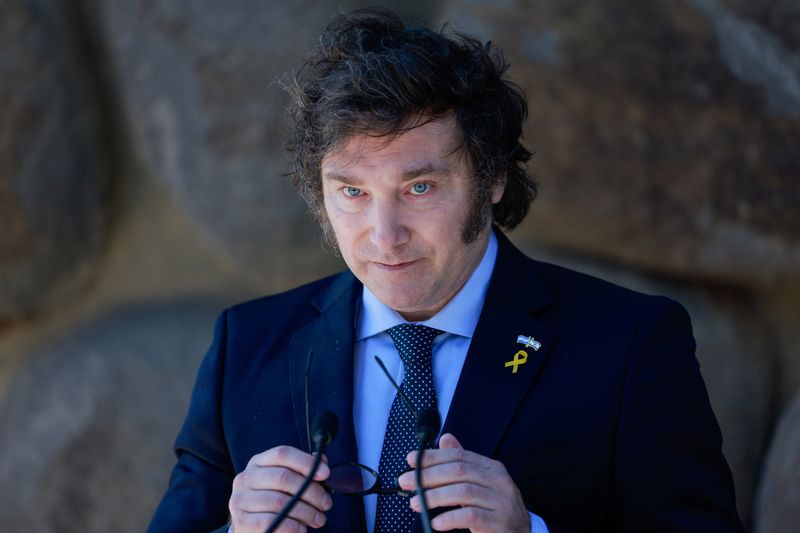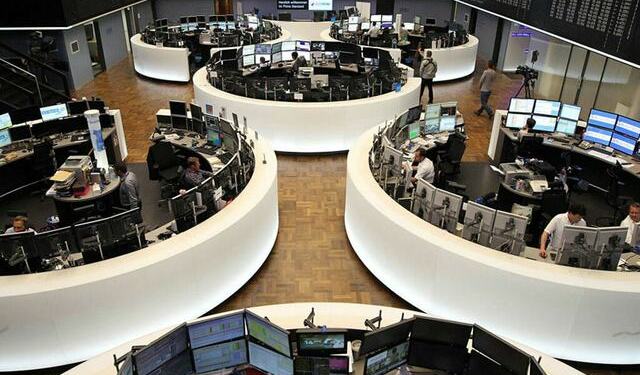2/2

© Reuters. Argentina’s President Javier Milei looks on during a visit to Yad Vashem, the World Holocaust Remembrance Centre, in Jerusalem, February 7, 2024. REUTERS/Ammar Awad/File Photo
2/2
By Jorge Otaola
BUENOS AIRES (Reuters) – Whisper it quietly, but Argentina’s embattled markets are showing signs of doubling down on the country’s no holds barred libertarian leader Javier Milei, betting he can pull the economy out of crisis.
Amid a painful economic downturn and with the government strapped for cash, Milei has made tough austerity a key focus since taking office in December, helping the country post its first monthly fiscal surplus for over a decade in January, music to the ears of investors after years of over-spending.
That hasn’t helped him make many friends with squeezed regional governors or unions – leading to a spike in protests – but has charmed investors, pushing some bonds to four-year highs and cutting Argentina’s risk index to a low since 2022.
“It seems the market is starting to believe,” said financial analyst Mariano Sardans at FDI Argentina, adding if it could be maintained it would strengthen the embattled peso, allowing tough currency controls limiting dollar access to be unwound.
Milei, who made the bold pledge of erasing a nearly 3% fiscal deficit from last year, has sought to make good on his word. His government has slashed spending, bought over $5 billion in dollars to build up depleted reserves and rolled over import debts with a successful issuance of ‘Bopreal’ bonds.
For now that’s bolstering market belief that Milei will follow through on his pledges to stabilize the economy, no easy task with studies suggesting poverty has risen towards 60% and with increasing protests on the streets.
“The market is becoming very optimistic about Javier Milei’s conviction,” said Javier Casabal, Buenos Aires-based fixed income strategist at Adcap Grupo Financiero.
“It’s a real shift worth celebrating, given that most investors did not have confidence in his ability to reduce the deficit just a few weeks ago. If anything, perhaps he’s going overboard in some ways.”
Some dollar bonds are at their highest level in four years, others near two-year highs, though they still trade in distressed territory around 35-45 cents on the dollar.
The South American country’s debt, however, remains risky with Argentina having defaulted nine times, most recently in 2020 before a major restructuring. Milei’s economic fixes face serious hurdles and push-back on the streets and in Congress.
But sentiment has been helped by improving exports, with a trade surplus in two straight months on stronger grains production after last year’s harvest was battered by drought.
Meanwhile, moves to mop up pesos in the market, including via short-term Treasury bills, have bolstered the currency and trimmed the gap between the controlled official exchange rate and popular parallel markets where dollars are more expensive.
That’s seen a strengthening in peso futures – a signal of where investors think the currency is heading – reflecting lower expectations of a sharp devaluation on the horizon following a mega 54% devaluation in December.
That said, the June futures contract still sees the peso at around 1,060 per dollar versus the current 838 peso spot rate, though down from predictions previously of over 1,400.
Mauro Mazza, analyst at Bull Market Brokers in Buenos Aires, said the positive momentum on the fiscal balance could help Argentine debt get price-boosting ratings upgrades, though would still retain so-called ‘junk’ status.
Milei’s government, in ongoing talks with the International Monetary Fund over the country’s $44 billion loan program, has said publicly it will push tougher measures than even the IMF is seeking to get the state’s finances in order.
An Argentina-based source at a ratings agency, who asked not to be named, said it was still too early to discuss upgrades.
“It wouldn’t be prudent to talk about potential ratings hikes, but it’s logical we’re monitoring Argentina’s situation.”
Source: Investing.com

























